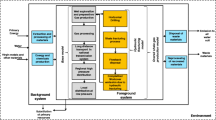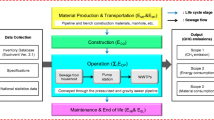Abstract
With the increase in natural gas (NG) production in recent years, primarily from shale gas, some sources, including the US Environmental Protection Agency (EPA), have suggested that upstream methane emissions are increasing. Much of the recent controversy has centered on emissions during well drilling, testing, and completion even though emissions downstream of the wellhead are also of concern. The study critically assessed the current state of knowledge about the life cycle GHG footprint of NG, analyzed the assumptions, data and analysis methodologies used in the existing literature. This study comprehensively analyzed the emission of methane from different stage of the life of well for conventional and unconventional NG using the EPA’s revised 2011 estimates as well as other existing literature and publicly available government data. The study proposed a probabilistic model to estimate the range of total GHG footprint of NG with varying probabilities. Through the bottom up approach starting from the well construction to the delivery of NG to the small user and using Monte Carlo simulation, the study identified the critical sources of fugitive emissions from the NG. As expected, emissions from well completion and periodic emissions (e.g. liquid unloading in the case of onshore conventional wells and workovers in the case of unconventional wells) are significant contributors to the overall GHG footprint of NG, and possess large opportunity for reduction. Finally the application of probabilistic model is demonstrated through a case study using the data from the Montney and Horn River shale gas basins in the Northern British Columbia to estimate the range of total GHG footprint of shale gas with varying probabilities. The study found that the GHG footprint of Montney and Horn River wells are much smaller than that of Barnett shale (which is representative of US shale gas) due to strict flaring regulations followed in BC. The study also undercuts the outcome of Howarth et al. (Clim Chang Lett 106:679–690, 2011), which states that the GHG footprint of shale gas is at least 20 % greater than coal.











Similar content being viewed by others
Abbreviations
- AGR:
-
Acid gas removal
- BC OGC:
-
British Columbia Oil and Gas Commission
- EPA:
-
Environmental Protection Agency
- EUR:
-
Estimated ultimate recovery
- GISS:
-
Goddard Institute for Space Studies
- GHG:
-
Greenhouse gas
- GWP:
-
Global warming potential
- IPCC:
-
Intergovernmental Panel on Climate Change
- MCS:
-
Monte Carlo simulation
- Mt:
-
Mega tonne
- MMT:
-
Million metric tonne
- Mcf:
-
Thousand cubic feet
- MMcf:
-
Million standard cubic feet
- NG:
-
Natural gas
- NMVOC:
-
Non-methane volatile organic compounds
- US NG:
-
United States natural gas
References
Abrahamsson M (2002) Uncertainty in quantitative risk analysis—characterization and methods of treatment. Department of Fire Safety Engineering, Lund University, Lund
API (2009a) Compendium of greenhouse gas emissions methodologies for the oil and natural gas industry. http://www.api.org/ehs/climate/new/upload/2009_GHG_COMPENDIUM.pdf
API (2009b) Hydraulic fracturing operations-well construction and integrity guidelines, API guidance document HF1, 1st edn., October 2009. http://www.shalegas.energy.gov/resources/HF1.pdf. Accessed 15 Mar 2012
Avanidou T (2003) Uncertainty and relative importance of hydraulic properties: a stochastic framework to prioritize site characterization and modeling needs. Master’s thesis, University of South Carolina, Columbia
Barcella ML, Gross S, Rajan S (2011) Mismeasuring methane: estimating greenhouse gas emissions from upstream natural gas development, HIS CERA. http://www.frackinginsider.com/IHS%20CERA.pdf. Accessed 15 Jan 2012
BC OGC (2011) Flaring, incinerating and venting reduction report for 2009. http://www.bcogc.ca/document.aspx?documentID=904. Accessed 14 Nov 2011
BC MEM, NEB (2011). Ultimate potential for unconventional natural gas in northeastern British Columbia’s Horn River basin, oil and gas reports 2011-1, BC Ministry of Energy and Mines & National Energy Board. http://www.em.gov.bc.ca/OG/Documents/HornRiverEMA_2.pdf. Accessed 14 Nov 2011
Broderick J, Anderson K, Wood R, Gilbert P, Sharmina M, Footitt A, Glynn S, Nicholls F (2011) Shale gas: an updated assessment of environmental and climate change impacts. A report commissioned by The Co-operative and undertaken by researchers at the Tyndall Centre, University of Manchester. http://www.tyndall.manchester.ac.uk/public/Tyndall_shale_update_2011_report.pdf. Accessed 28 Mar 2012
CAPP (2011) Upstream dialogue: the facts on natural gas, 60 p. http://www.capp.ca/getdoc.aspx?DocId=196037&DT=NTV. Accessed 29 Nov 2011
Cullen AC, Frey HC (1999) Probabilistic techniques in exposure assessment: a handbook for dealing with variability and uncertainty in models and inputs. Plenum, New York
Energy Information Administration (2011a) Emissions of greenhouse gases in the United States, 2009, p 86
Energy Information Administration (2011b) Annual energy outlook 2011: early release overview, p 246
Environment Canada (2011) Canada’s emissions trends, July 2011, p 60. ISBN 978-1-100-17743-4. http://www.ec.gc.ca/Publications/E197D5E7-1AE3-4A06-B4FC-CB74EAAAA60F%5CCanadasEmissionsTrends.pdf. Accessed 15 Mar 2012
EPA (2001) Risk assessment guidance for superfund: volume III—part A, process for conducting probabilistic risk assessment. EPA 540-R-02-002. U.S. Environmental Protection Agency. http://www.epa.gov/oswer/riskassessment/rags3adt/. Accessed 30 Nov 2011
EPA (2007) Reducing methane emissions during completion operations. Natural Gas STAR Pro-ducer’s Technology Transfer Workshop, 11 September 2007. http://epa.gov/gasstar/documents/workshops/glenwood-2007/04_recs.pdf. Accessed 30 Nov 2011
Everett CB (2010) EPA’s proposes GHG reporting rules for natural gas. http://marcellusshale.saulnews.com/archives/113. Accessed 20 Mar 2012
Fernandez R, Petrusak R, Robinson D, Zavadil D (2005) Cost-effective methane emissions reductions for small and midsize natural gas producers (Reprinted from the June 2005 issue of Journal of Petroleum Technology). http://www.icfi.com/Markets/Environment/doc_files/methane-emissions.pdf. Accessed 30 Nov 2011
Forster P, Ramaswamy V, Artaxo P, Berntsen T, Betts R, Fahey DW et al (2007) Changes in atmospheric constituents and in radiative forcing. Intergovernmental Panel on Climate Change, Cambridge and New York
Frey HC (2007) Quantification of uncertainty in emission factors and inventories. In: Proceedings of the 16th annual international emission inventory conference, emission inventories: integration, analysis, and communications, Raleigh, 14–17 May, p 16. http://www.epa.gov/ttnchie1/conference/ei16/session5/frey.pdf. Accessed 25 Mar 2012
Fulton M, Mellquist N, Kitasei S, Bluestein J (2011) Comparing life cycle greenhouse gas emissions from natural gas and coal. Deustsche Bank Group and Worldwatch Institute. 25 Aug 2011. http://www.worldwatch.org/system/files/pdf/Natural_Gas_LCA_Update_082511.pdf. Accessed 15 Mar 2012
GAO (2010) Federal oil and gas leases: opportunities exist to capture vented and flared natural gas, which would increase royalty payments and reduce greenhouse gases. GAO-11–34 U.S. General Accountability Office Washington, DC. http://www.gao.gov/new.items/d1134.pdf. Accessed 30 Nov 2011
GRI (1996) GRI report, methane emissions from the natural gas industry, vol 1–15. Energy Information Agency (U.S. DOE). http://epa.gov/gasstar/tools/related.html. Accessed 30 Nov 2011
Hayhoe K, Kheshgi HS, Jain AK, Wuebbles DJ (2002) Substitution of natural gas for coal: climatic effects of utility sector emissions. Clim Chang 54:107–139
Howard PH, McColl D, Mutysheva D (2006). Capacity of the western Canada natural gas pipeline system, Study No. 113, Canadian Energy Research Institute, October 2006, p 102. ISBN 1-896091-63-7. http://lba.legis.state.ak.us/proposals/doc_log/2008-03-25_ceri_study_113_vol_1_ak.pdf. Accessed 7 Jan 2012
Howarth RW, Santoro R, Ingraffea A (2011) Methane and the greenhouse-gas footprint of natural gas from shale formations. Clim Chang Lett 106:679–690
Hughes JD (2011) Life cycle greenhouse gas emission from shale gas compared to coal: an analysis of two conflicting studies. http://www.postcarbon.org/reports/PCI-Hughes-NETL-Cornell-Comparison.pdf. Accessed 28 Mar 2012
Hultman N, Rebois D, Scholten M, Ramig C (2011) The greenhouse impact of unconventional gas for electricity generation. Environ Res Lett 6(044008):9
Jaccard M, Griffin B (2010) Shale gas and climate targets: can they be reconciled? Pacific institute for climate studies, p 12. http://www.pics.uvic.ca/assets/pdf/publications/WP_Shale_Gas_and_Climate_Targets_August2010.pdf. Accessed 15 Jan 2012
Jiang M, Griffin WM, Hendrickson C, Jaramillo P, VanBriesen J, Venkatesh A (2011) Life cycle greenhouse gas emissions of Marcellus shale gas. Environ Res Lett 6:9
Johnson P (1996) Uncertainty of hydraulic parameters. J Hydraul Eng 112(2):112–114
Kenarangui R (1991) Event-tree analysis by fuzzy probability. IEEE Trans Reliab 40(1):12–124
Loveridge M, Rahman A (2014) Quantifying uncertainty in rainfall-runoff models due to design losses using Monte Carlo simulation: a case study in New South Wales, Australia. Stoch Env Res Risk Assess. doi:10.1007/s00477-014-0862-y
Lyle D (2011) Shales revive oil patch, gas patch. 2011 North American Unconventional Yearbook, 2010
National Energy Board (2009) Energy briefing note: a primer for understanding Canadian shale gas. Queen’s Printer for Canada, Calgary
National Energy Board (2011). Fact sheet: Canada’s Energy Future: Energy Supply and Demand Projections to 2035—Natural gas liquids outlook highlights. http://www.neb-one.gc.ca/clf-nsi/rnrgynfmtn/nrgyrprt/nrgyftr/2011/fctsht1134ntrlgslqd-eng.html. Accessed 25 Mar 2012
Prasher S, Russell S (1984) First and second order analyses of parameter uncertainty in drainage design. Trans ASAE 27(4):1081–1086
Qin XS (2012) Assessing environmental risks through fuzzy parameterized probabilistic analysis. Stoch Env Res Risk Assess 26(1):43–58
Rojey A (1997) Natural gas: production, processing, transport, p 429
Shindell DT, Faluvegi G, Koch DM, Schmidt GA, Unger N, Bauer SE (2009) Improved attribution of climate forcing to emissions. Science 326:716–718
Skone TJ, Littlefield J, Marriott J (2011) Life cycle greenhouse gas inventory of natural gas extraction, delivery and electricity production, DOE/NETL-2011/1522. http://www.netl.doe.gov/energy-analyses/pubs/NG-GHG-LCI.pdf. Accessed 14 Nov 2011
Soeder DJ, Kappel WM (2009) Water resources and natural gas production from the Marcellus shale. US Geological Survey Fact Sheet 2009-3032, p 6
Solomon S, Qin D, Manning M, Chen Z, Marquis M, Averyt KB, Tignor M, Miller HL (eds) (2007) Contribution of working group I to the fourth assessment of the Intergovernmental Panel on Climate Change. Cambridge University Press, Cambridge
Unger N, Bond TC, Wang JS, Koch DM, Menon S, Shindell DT, Bauer SE (2010) Attribution of climate forcing to economic sectors. Proc Natl Acad Sci USA 107(8):3382–3387
U.S. Environmental Protection Agency (2008). Inventory of U.S. Greenhouse Gas Emissions and Sinks: 1990–2006. http://www.epa.gov/climatechange/emissions/downloads/08_CR.pdf. Accessed 30 Mar 2012
U.S. Environmental Protection Agency (2011a) Greenhouse gas emissions reporting from the petroleum and natural gas industry: background technical support document. Washington, DC: U.S. Environmental Protection Agency, Climate Change Division. http://www.epa.gov/climatechange/emissions/downloads10/Subpart-W_TSD.pdf. Accessed 29 Nov 2011
U.S. Environmental Protection Agency (2011b) U.S. greenhouse gas inventory report: Inventory of U.S. Greenhouse Gas Emissions and Sinks: 1990–2009, April 2011, Washington, DC, 2011. http://www.epa.gov/climatechange/emissions/usinventoryreport.html. Accessed 30 Nov 2011
U.S. Environmental Protection Agency (2011c) Natural Gas STAR Program: recommended technologies and practices. www.epa.gov/gasstar/tools/recommended.html. Accessed 30 Nov 2011
Wood R, Gilbert P, Sharmina M, Anderson K, Fottitt A, Glynn S, Nicholls F (2011) Shale gas: a provisional assessment of climate change and environmental impacts. Tyndall Center, University of Manchester, Manchester, England. http://www.tyndall.ac.uk/sites/default/files/tyndallCoop_shale_gas_report_final.pdf
Yeh K, Tung Y (1993) Uncertainty and sensitivity analysis of pit-migration model. J Hydraul Eng 119(2):262–283
Acknowledgments
The authors gratefully acknowledge the funding provided by British Columbia Oil and Gas Commission (BC OGC) to conduct the study. The authors also appreciate the time and technical support provided by BC OGC personnel.
Disclaimer
This paper used data collected from BC OGC. However, the results represented here are not the responsibility of BC OGC.
Author information
Authors and Affiliations
Corresponding author
Rights and permissions
About this article
Cite this article
Shahriar, A., Sadiq, R. & Tesfamariam, S. Life cycle greenhouse gas footprint of shale gas: a probabilistic approach. Stoch Environ Res Risk Assess 28, 2185–2204 (2014). https://doi.org/10.1007/s00477-014-0874-7
Published:
Issue Date:
DOI: https://doi.org/10.1007/s00477-014-0874-7




